How To Cut A Straight Line With Scissors
Learning how to cut fabric directly is an essential skill that will help you go great, professional-looking results in your sewing projects. I will show you lot 8 like shooting fish in a barrel ways to do it. And once you lot know how, it volition exist a skill you can utilise over and over again whether you are making a simple pillow or a complicated garment.
Cutting fabric straight is really important and can't be stressed enough. A bad initial cut tin can result in:
- Seams of different lengths on two pieces that are supposed to friction match
- Deformed/uneven hem later the garment is finished
- Twisted seams
The skill of knowing how to cut fabric in a straight line seems similar a simple task. Only in reality, there is more to it than is obvious at first glance.
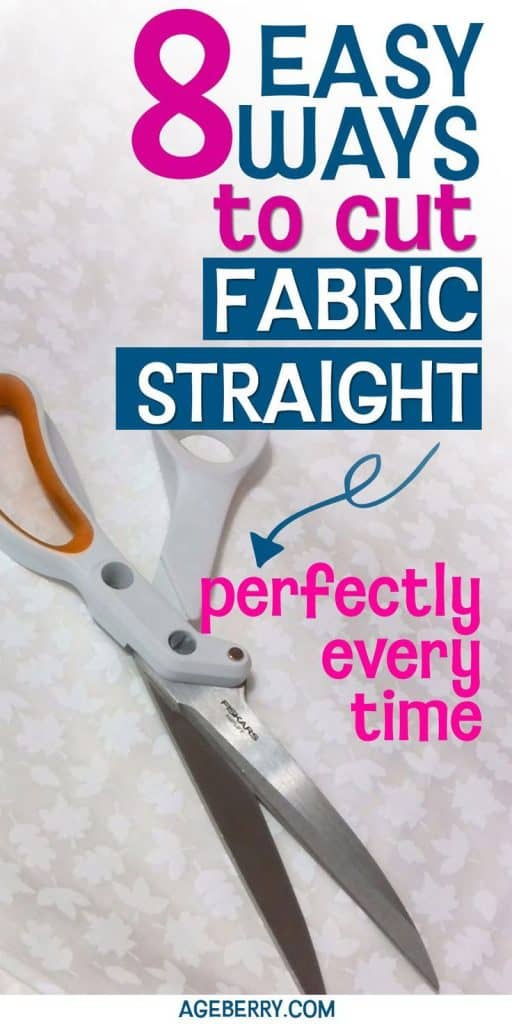
How To Properly Ready Your Fabric To Exist Cut Straight
Unfortunately, fabric cut in the store is not always perfectly directly. Sometimes the bevel tin can be 5-x cm or even more. So, earlier you can use your fabric for any projection, you'll need to find out how to get a directly border on information technology.
Proper grooming of the fabric is vital in sewing.
What would happen if yous make curtains from textile without straightening its edges, for case? Well, if you hang those curtains, any unevenness volition immediately exist visible, believe me. Therefore, it is very important to straighten fabric edges for whatever sewing project Before cut blueprint pieces.
Sometimes cloth can exist stretched off-grain in manufacturing and you will besides need to square upward the textile (aka put it back on-grain) before cutting if you lot see that the textile is off-grain. If you need to know how to observe out if your fabric is on-grain or off-grain, check out my tutorial onhow to square up fabric. At that place, you lot'll learn how to cut on the direct grain of the material. (I also have a YouTube video to walk you through it fifty-fifty more than.)
In the prototype below, you lot can meet that this blue fabric from which I was going to make a skirt is not cut straight. When I tried to fold my fabric selvage to selvage (before cutting pattern pieces from it), in that location was a bubble in the fold at the bottom. However, after cutting the fabric straight, I was able to fold it properly.
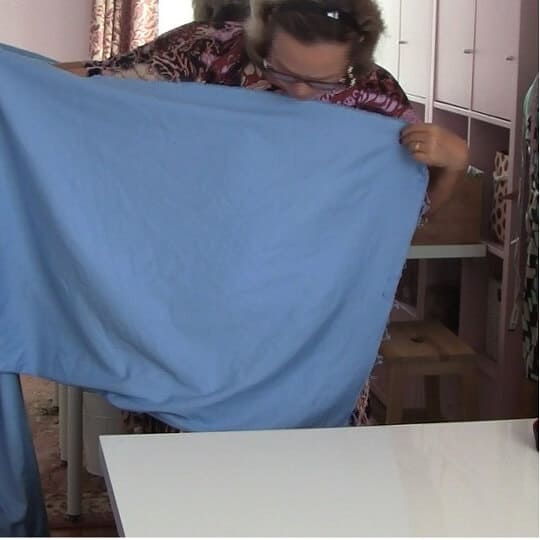
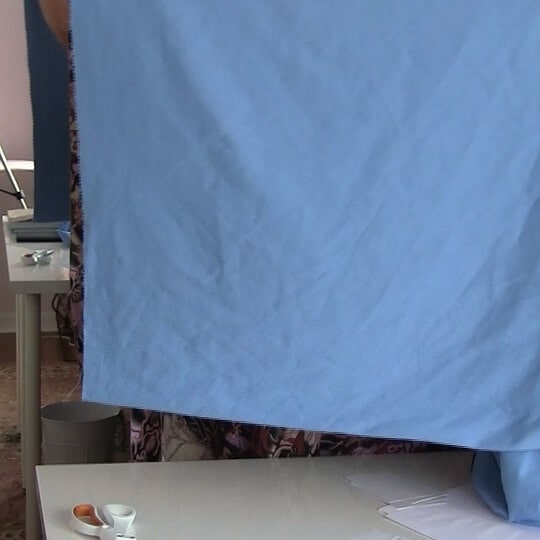
It might too be helpful to check out my tutorial onhow to cut fabric on the bias.
There are quite a few methods for cutting fabric directly. But no matter how you lot become about it, you will need to practise some preparation earlier measuring and cutting for your side by side project.
Decide Whether Your Fabric Is Woven, Knitted, Or Non-Woven
The manufacturing procedure produces differences between the 3 types of fabric. It's of import to know because yous will cutting them differently.
Woven Fabrics
Woven fabric is fabricated of many threads that run vertically and horizontally in a crisscross pattern. These fabrics unremarkably go along their shape and practise non stretch unless the threads themselves have some give. For example, some woven fabrics may have elastane threads which will, in plow, make the textile feel a piddling stretchy.
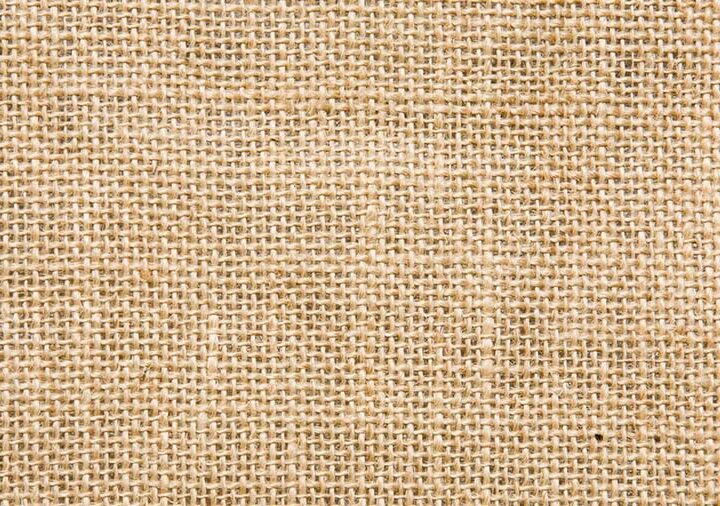
Knit Fabrics
Fabric that has one continuous thread being looped back and forth is known as knit textile. Manufacturers make knits using a serial of needles to loop and interlock fibers. Knits stretch vertically and horizontally, and the amount of stretch differs.
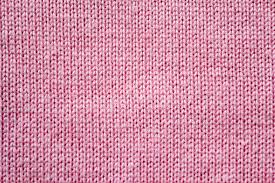
Not-Woven Fabrics
Non-woven fabrics (such equally felt, vinyl, or fusible interfacing) are bonded together mechanically, thermally, or chemically. They are flat, porous sheets that are fabricated directly from split up fibers or from molten plastic or plastic film.
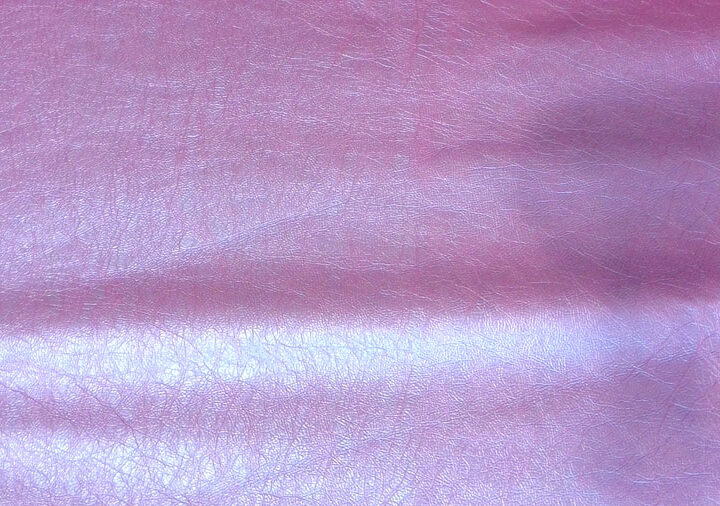
Note: All woven and knit fabrics take selvages – self-finished edges of fabric that keep it from unraveling and fraying. When you lot buy a slice of fabric from a shop, you lot volition have a selvage forth both sides of your textile. The good news is that selvage edges are usually straight. Fabrics also have a grainline, which is the management of threads running parallel to selvages. In other words, the grainline is the lengthwise direction of the piece of the fabric.
Iron Woven Fabric Flat Start
Cloth coming from fabric stores is ofttimes folded in one-half lengthwise, matching the selvages. So you lot might need to get rid of the fold first.
Straightening fabric before cutting involves getting rid of the folds and wrinkles by ironing them out. However, this really only applies to woven fabrics because, generally, you don't need to iron knit or non-woven fabric.
Prepare A Large, Flat, Hard Work Surface
A big square tabular array is the best (I bought mine in Ikea). It's better to avert cutting fabric on a bed or a carpeted floor if possible. If y'all utilise a dining table, extend information technology to its maximum length and go along the table uncluttered. Put all the fabric edges on the table and ensure that nothing is hanging over the table and pulling the cloth down.
Merely if all else fails, merely use the flooring.
Prepare Proper Cut Tools
Proficient sewing shears are a must-have tool for cutting textile direct! They have to be comfortable for your hand and very sharp. Or you tin utilize a rotary cutter. But I accept a special very detailed commodity on cutting tools for sewing, then you may want to check it out.
eight Easy Methods For Cutting Fabric Straight
Okay, now you are set to learn different methods of cutting fabric perfectly straight.
#1. Pulling A Thread To Cut Fabric Directly
This first method is my favorite. I think it'south ane of the all-time ways to cutting cloth direct because it can exist used for many woven fabrics. As well, it's very unproblematic, precise, and requires but attention and patience. But it'south proficient for cutting ONLY woven fabric, can't be used for knits or non-woven.
Hither's how to cutting material direct by pulling a thread:
- Observe the unfinished edge of the fabric (perpendicular to the selvages).
- Pick out a single thread on the frayed edge and advisedly pull it.
- As you pull, the fabric will gather a little. Straighten the cloth and pull the thread out completely.
- You will discover that it left a visible gap line. Gently cutting the fabric along this "path."
- As you pull the thread, it can break before you reach the selvage. Not a trouble. Cutting along the path till you lot get to the place where your thread snapped. Afterward that, cull some other thread in the aforementioned line and repeat the process until y'all cut to the selvage.
Your cut will be perfectly straight. Cut with one hand belongings the fabric and the other manus holding the scissors. Don't elevator the fabric from the tabular array.
The image and curt video below testify the procedure.
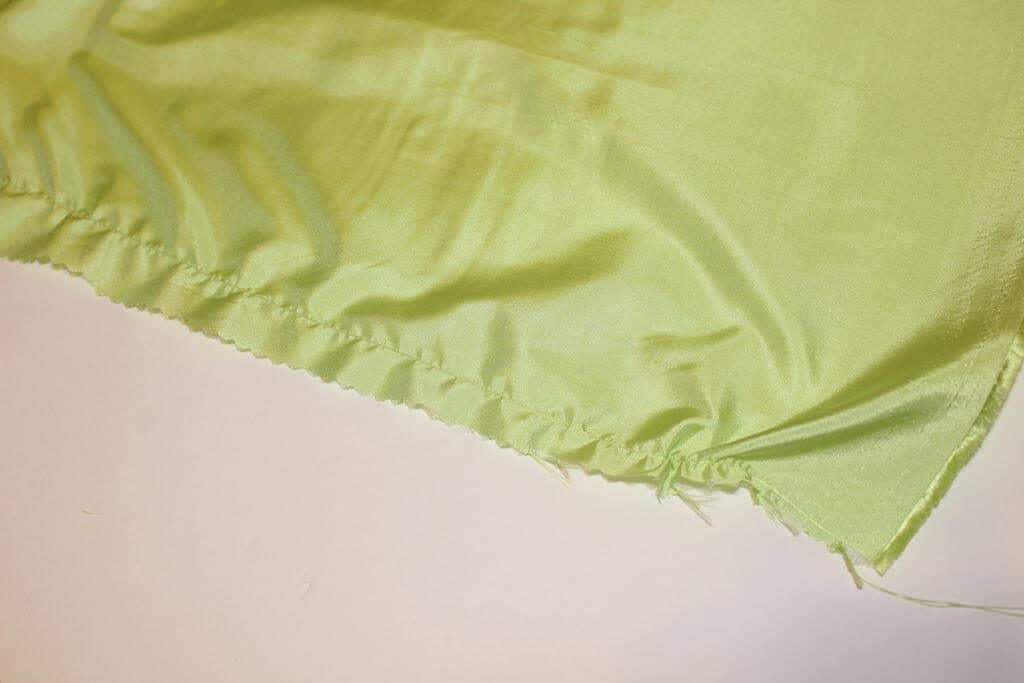
#2. Cut Cloth Directly Using 90 Caste Right Angle Tools
The first method does not work well for knit fabrics. So this second method is good for use with knits. By the way, it is likewise skilful for some woven fabric (especially if y'all can't easily pull the thread) as well equally non-woven materials.
Here's how to cut fabric in a straight line:
- Line up one selvage edge of the textile with one of the edges of the table.
- Put some weights on the fabric or fix information technology with the painter's tape so that the material doesn't move.
- Now, look at how the cut border of the fabric aligns with the other edge of the tabular array perpendicular to the beginning one. You lot might see that the fabric goes slightly outward or inward from the table border.
- Motility the material so that nix is going inward.
- Using a table edge, brand marks on the cloth, draw a line, and cut.
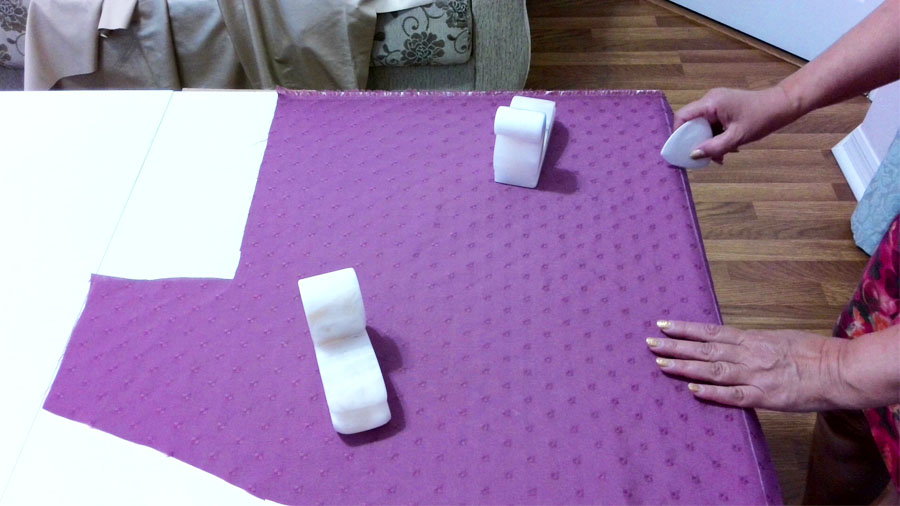
Cutting Textile Straight Using a Straight Angle Ruler
It'due south very like shooting fish in a barrel to cutting fabric direct with a 90-degree ruler. Hither's how I exercise it:
- Lay the ruler on the material and then that one side lines up forth the selvage border. The other side of the ruler will cross the cloth at a xc-degree angle.
- Concur the ruler firmly in identify and utilize a marker to describe a line. This line will be perfectly straight and perpendicular to the selvage.
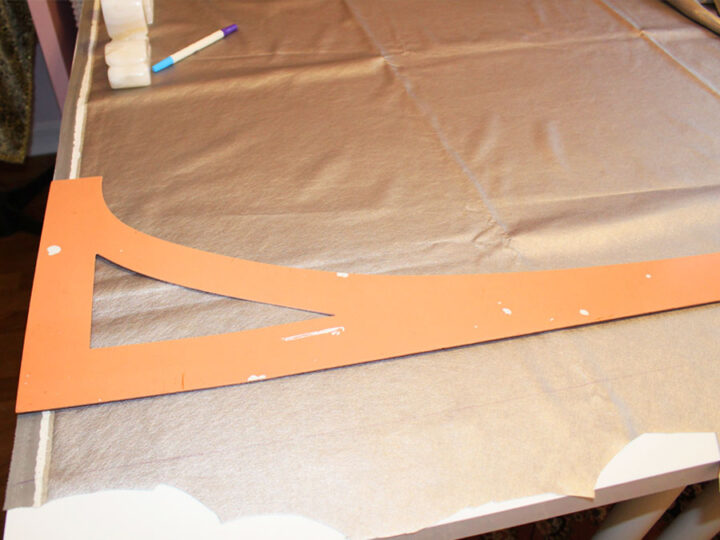
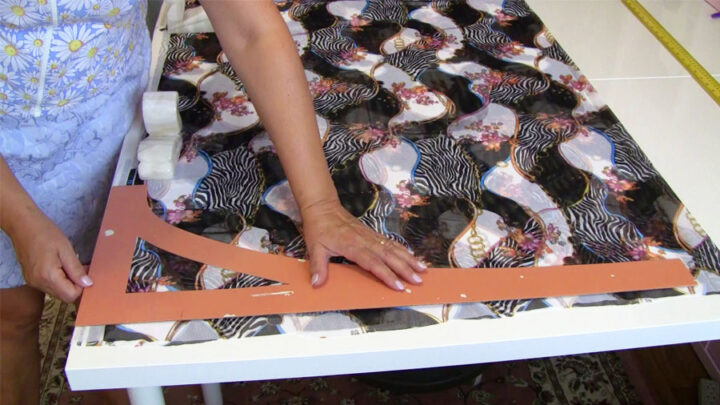
Using The Grainline For Knits
I take to mention hither thatknits also have a grainline, but it'south different than on woven fabric.
The grainline on thick knits tin can actually be seen. The little vertical rib lines in the shape of v-stitches on the right side brand the grainline, like on a knitted garment. So if yous want to cut knit fabric direct, you accept to cut along the grainline.
In the paradigm below, you can see raw silk knit fabric with grainlines hands visible. Sometimes I trace a line of basting stitches along the grainline only to be certain that I cut fabric directly.
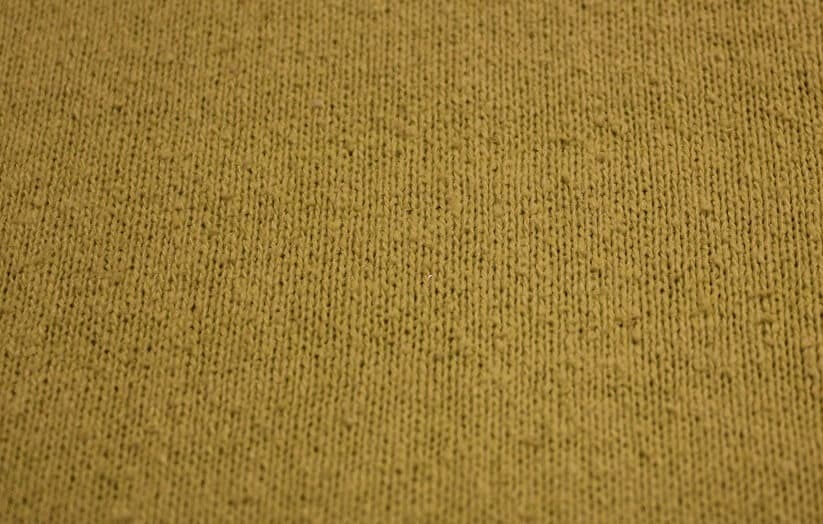
✅ Related tutorial: How To Cut Knit Material: Ultimate Guide
But most of my knits are very thin because I like to stitch with gorgeous silk bailiwick of jersey textile, and the grainlines can't be seen there. In this case, I just observe the grainline with my ruler because the grainline is parallel to the selvage line.
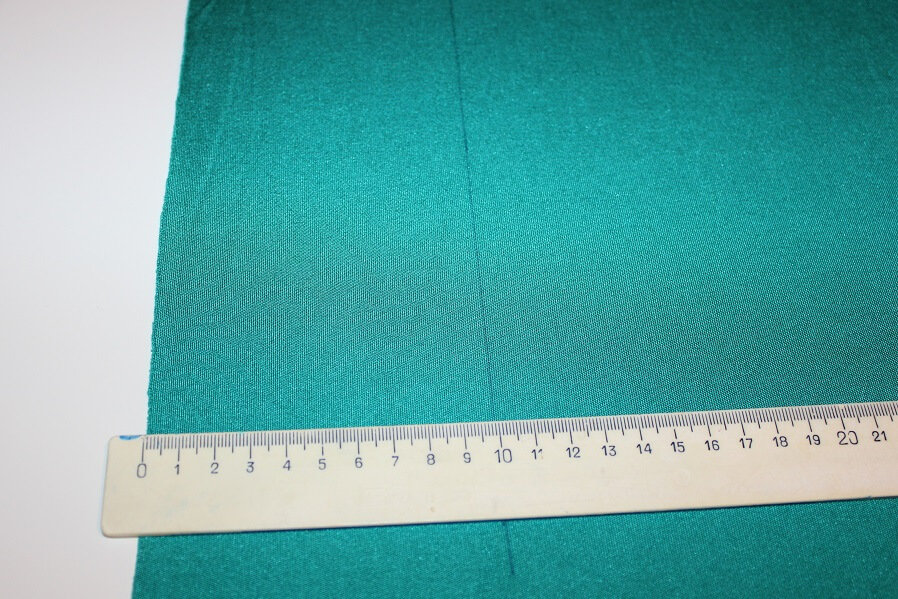
It'south actually important to cut knits forth the straight grain on textile. Otherwise, you tin can terminate upwardly with twisted side seams and completely distorted garments (usually, it happens after washing them in the laundry).
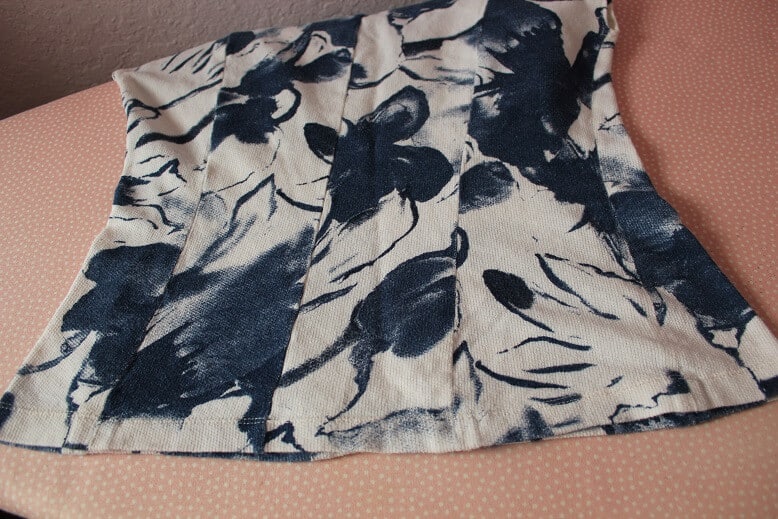
Simply sometimes, cutting knit fabric straight may be very hard because the edges of the knit fabric often roll. In my YouTube video, I am showing how to how to finish knit fabric edges from curling, how to set knit fabrics for cutting.
————————————————
When you take at least two straight lines on the fabric (the one you simply cut and the selvage edge), you can measure from these straight edges whatever size square or rectangle you need. Measure with a ruler the amount you need for your project and cut.
This assumes that you lot have more fabric than y'all demand, of course.
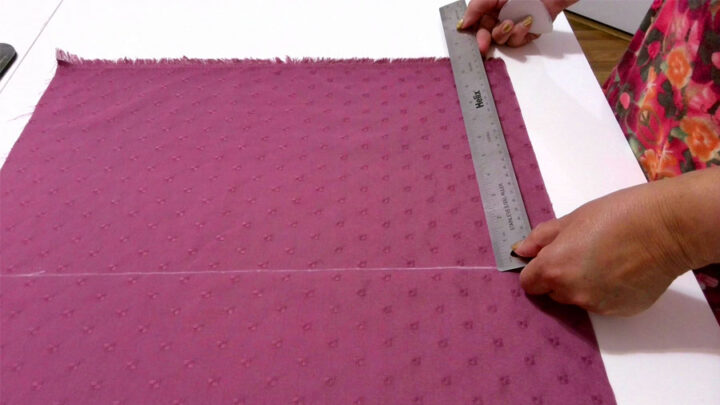
Note: Some of the links on this page are chapter links. This means I will receive a commission if you order a product through one of my links. I merely recommend products I believe in and utilise myself.
#iii. Using A Large Cutting Mat, A Ruler And A Rotary Cutter to Cut Cloth Direct
For a long time, I thought that a cutting mat and a rotary cutter are only used by quilters. Now I know I was completely wrong.
A cutting mat and a rotary cutter are essential tools for whatever serious sewist. They help to ensure precise direct cuts when cut fabric, and can brand the departure between a successful project and a disastrous one.
A cutting mat provides a stable, cocky-healing surface to cutting fabric on, and the filigree lines brand information technology like shooting fish in a barrel to measure and cut fabric accurately. Near cutting mats are marked with one-inch filigree lines and also bias lines.
Y'all can find cutting mats in a variety of sizes, just for sewing and cutting full widths of fabric right from the bolt, it'southward improve to use a bigger size like 24" x 36" or even bigger.
To cut fabric on a cutting mat, start by aligning the directly edge of the fabric (a selvage border or a folded edge parallel to the selvages) with i of the cutting lines on the mat. Make sure that the fabric (and a ruler) are aligned with the lines on the cutting mat. And so, apply a rotary cutter to slowly and carefully cutting along the cutting line. Remember to use some pressure as you lot movement your rotary cutter along the textile. If you find that the fabric is slipping, but reposition it on the mat and continue cutting. Employ fabric weights to hold large pieces of fabric (I utilise my stone figurines as textile weights).
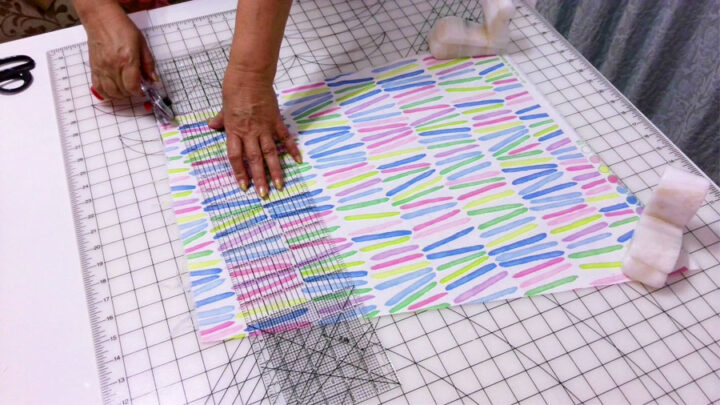
#4. Ripping The Fabric
The fourth method is very precise also: tearing the fabric instead of cut.
You lot have probably seen this done in stores considering it is the fastest method to cut fabric. And when practical correctly, information technology works similar a amuse! But it must be noted – this method is applicable only to woven fabrics – mostly lightweight natural fabrics. It does not work for all fabrics or in all situations.
I rip many lightweight fabrics – silk, cotton, and even thin wool. The ripped fabric edge tin become noticeably more loose or wavy. But information technology will be perfectly straight, though. If you don't want this ripped edge (which can look a little distressed), measure a small distance from that edge, depict a straight line parallel to the ripped border, and cutting with pair of scissors.
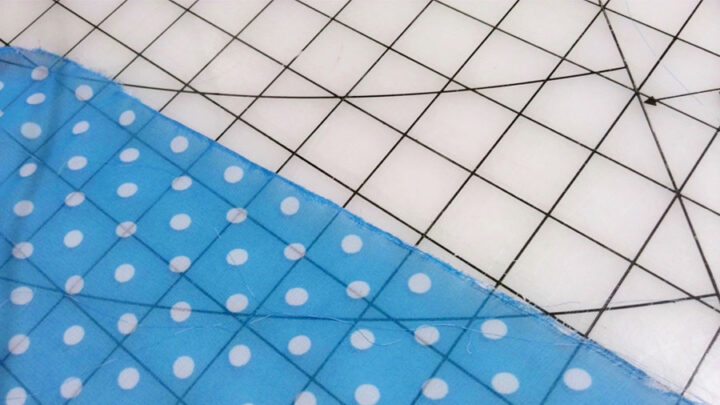
This method is especially practiced when y'all want to employ fabric previously cutting for some other project where you can't even find selvage edges, but y'all do know where they were initially.
How do you rip the fabric?
Just snip fabric with pair of scissors about 1 inch from the edge, then pull the fabric apart.
Hither are a few things to remember:
- Ripping very close to the border of the fabric may non be successful.
- Don't rip woven textile with elastane in it.
- Don't rip fabric along grainlines (sometimes it works though).
- It'due south usually adept for direction on crossgrain lines going perpendicular to selvages (selvage to selvage rip).
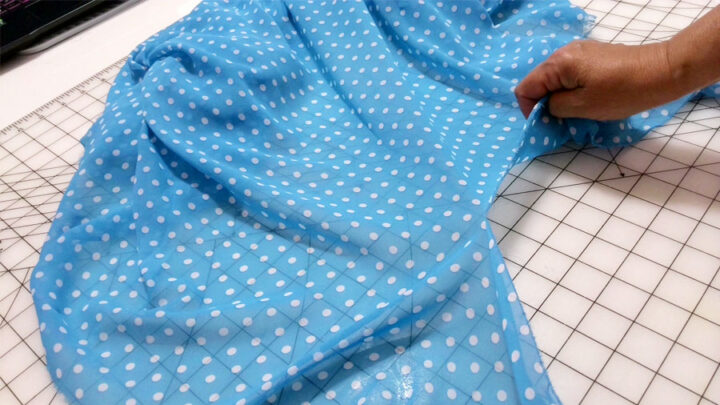
The image below shows how the cotton fiber fabric edge looks later ripping:
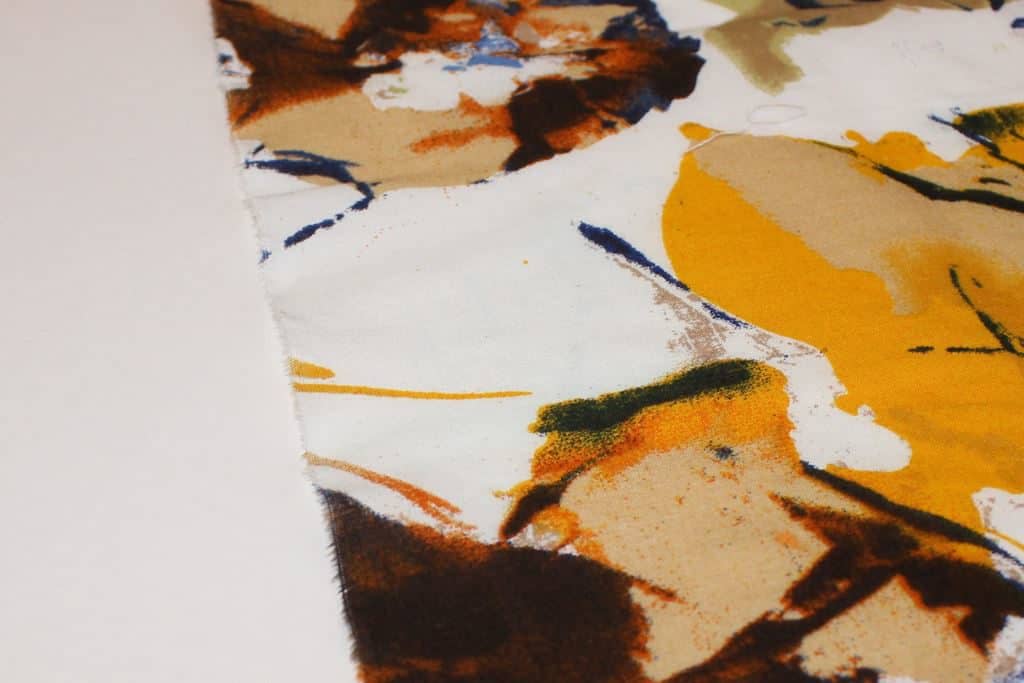
#5. Folding Selvage-To-Selvage Crosswise (Non Lengthwise)
This method is non really very useful considering it doesn't let you to cutting close to the cut edges of the fabric. So, it is good only if yous want to accept a directly cut in the middle of the fabric slice or close to it. Y'all tin't cut very close to the edge with this method because y'all demand a length of selvage to make sure you align information technology properly.
Use this method when y'all demand to cut the fabric perpendicular to the selvages. Yous will demand to make sure the selvages are straight before folding. Otherwise, information technology will not exist possible to use this method.
- Fold the fabric in half in length and advisedly align the selvages.
- Polish the fabric with your hands so there are no wrinkles anywhere.
- And the folded line will be directly.
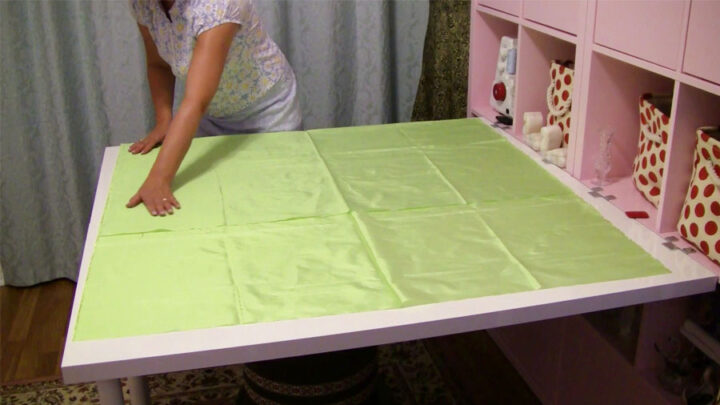
But you lot can besides use this method if your fabric doesn't take 2 selvage edges and instead has only one selvage and one straight edge parallel to the selvage. So you lot can fold the fabric every bit I described above and the folded edge will be straight and exactly perpendicular to the selvage edge.
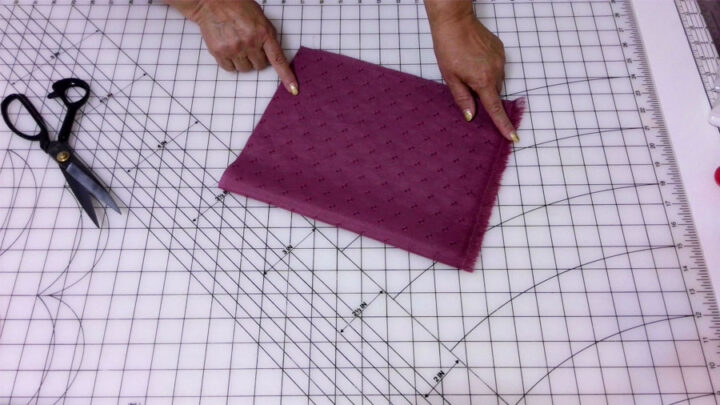
#half dozen. Cutting Textile Straight Using A Print On The Fabric Or Design
If there is a certain pattern or texture on the fabric that will help you cut straight, you're lucky! So, if you lot desire a straight cut on the fabric with stripes, plaids, or some prints, you can follow the designs on the material.
Using the design already on the fabric makes information technology easier to cutting either parallel or perpendicular on the pattern lines. Yous may need to draw helping lines using a ruler, or you may piece of work without, depending on the pattern.
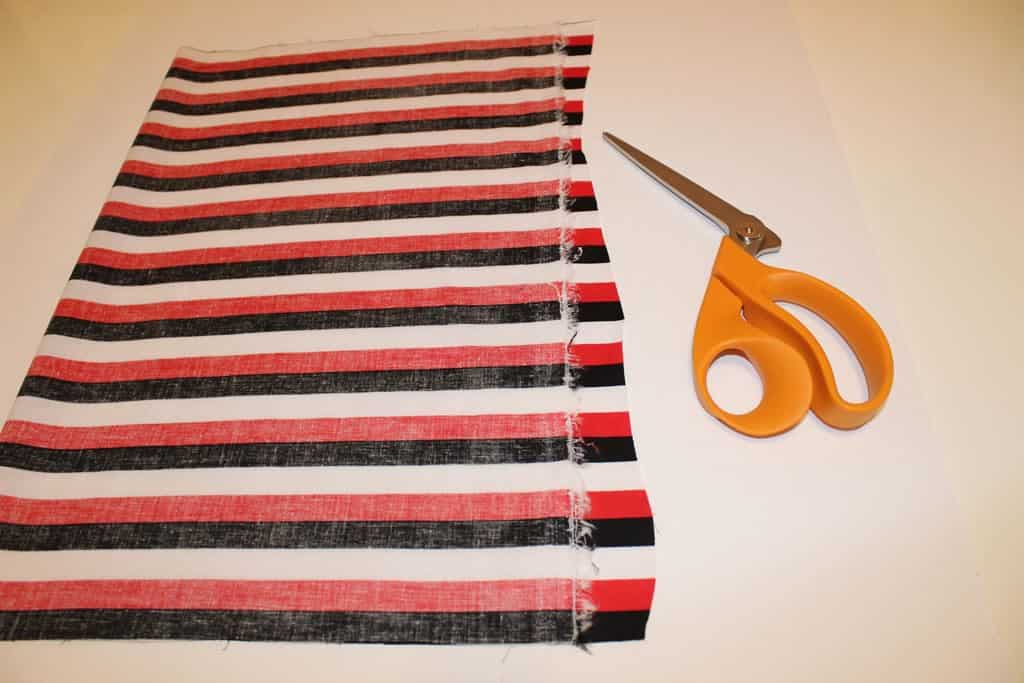
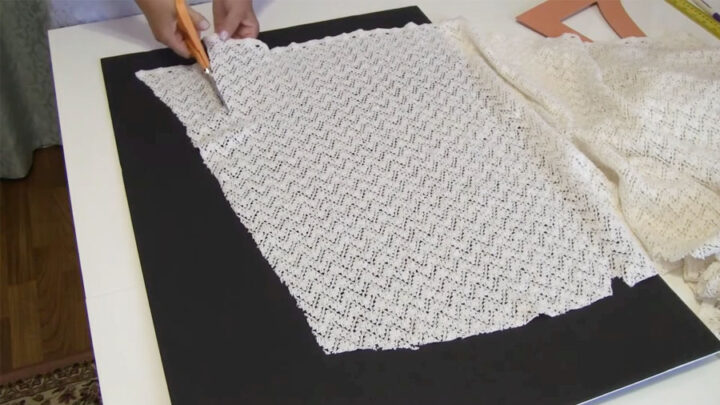
#vii. Using Laser-Guided Tools To Cut Textile Straight
There is a special tool for cutting material straight. It's calledLight amplification by stimulated emission of radiation-Guided Material Scissors. Co-ordinate to the instructions, y'all are supposed to describe a line on the back of the item to be cut and line up the laser with that line every bit you are cut.
So, I don't meet a point to employ this laser if I have to draw the line anyway. If I draw the line, I might every bit well cut along the line with regular sewing scissors. Moreover, it is difficult to keep the scissors from shifting with the move of my hand, making the laser point in a different direction.
And then for me, these scissors are really not something I would consider.
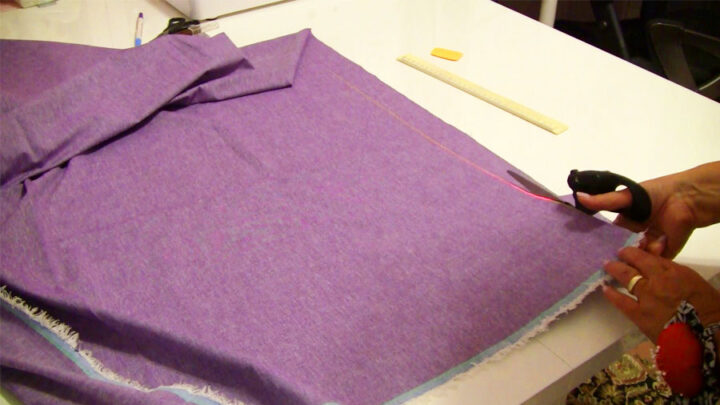
#8. Lazy Method Of Cutting Cloth Direct
When you need to cut squares or rectangles and you lot are in a hurry and don't want to mark cut lines with a ruler, you can follow this technique:
- Make a minor cut perpendicular to the selvage (you can utilize a small triangular ruler or something with a xc-degree bending for this because it must be precise).
- Next, fold it upwards and go on the edges fifty-fifty along the side that you already cut.
- Now cutting along the folded-over material. Repeat the process as needed until yous reach the other selvage line.
This method is by and large good for sturdy cotton fiber fabric.
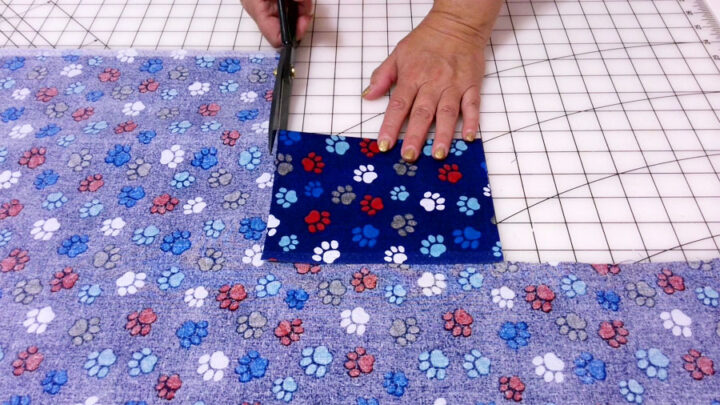
Tools For Cutting Cloth Direct
One way to ensure you cut cloth directly is to utilise the right tools. For cutting material directly, you need to have a sharp pair of sewing scissors, a rotary cutter, a few different rulers, and a cut mat. With these tools, you'll be able to make precise, make clean cuts that will help your sewing projection look its best. Yous can read a detailed guide on cut tools for sewing on my site:
How To Cut Fabric In A Directly Line With Scissors
I use both pair of scissors and a rotary cutter interchangeably, depending on the textile I'm working with and the types of cuts I'thou trying to make. If I'm only making small cuts or a few of them, I tend to reach for my scissors.
It's important to choose a pair of high-quality, heavy-duty scissors with sharp blades that volition precisely cut your fabric. Going cheap will likely result in rips, frays, and ruined fabric.
To utilize pair of scissors for cutting fabric straight, merely describe a line where you want to cut (or line information technology up another way to help y'all stay straight). Then glide your scissors into place, get-go cut, and spotter the blades snip through the fabric with ease.
Don't have a good pair of scissors for sewing? Recently I bought these pair of scissors and at present I am sure these are the all-time material pair of scissors I have ever had.
These aren't just any fabric scissors. These are the heavy-duty fabric sheers you won't want to be without. It'south written PROSHEAR on them. They are black because they are fabricated of loftier carbon steel, a stronger metal than stainless steel. They brand clean cuts through multiple layers of fabric--they're sharper than anything else out there!
How To Cut Textile Straight With A Rotary Cutter
A rotary cutter is a keen tool for cutting fabric straight quickly and accurately. It looks very similar to a pizza cutter, simply unlike a pizza cutter, it comes in a variety of sizes (45mm and 60mm being the nigh common). It has a cylindrical bract that rotates. Rotary cutters are very abrupt and you do need to be very careful when using them so you don't accidentally cutting yourself.
When using a rotary cutter, at that place are a few things to keep in mind in order to get the all-time results.
First, exist sure to utilize a cutting mat. This volition help protect your working surface and proceed the cloth from slipping. Second, position the rotary cutter so that the bract is perpendicular to the textile. This volition give you the all-time command and prevent the textile from bunching up. Finally, holding the fabric in place with a ruler, so it doesn't sideslip, push button the rotary cutter along the ruler's edge where you want to cutting. The blade will take intendance of the rest (if it's not slow of course).
Before using a rotary cutter, always make sure the blade is properly attached and fixed so it won't skid out as you lot cutting. Ever cut away from yourself, not towards yourself. Put the blade cover on when you're non cut. Store your rotary cutter in a safe identify away from children and pets.
There are many types of rotary cutters out in that location, though, most with their own special designs/purposes and so make sure to weigh out your options carefully before deciding on which 1 is the best for y'all. My favorite is Martelli rotary cutter.
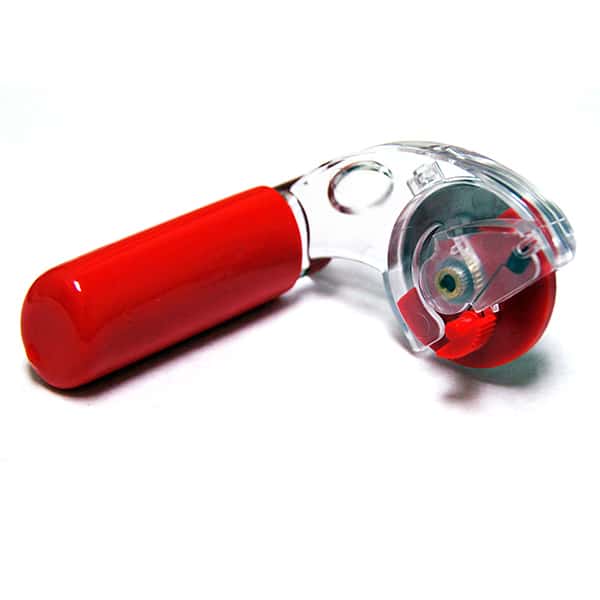
Sewing rulers to cutting fabric straight
Sewing rulers are specially designed to assist you cut fabric straight, and they're an essential tool for any sewing projection. There are many different types of rulers, merely the most useful type is the straight angle ruler. Straight angle rulers are the best choice for cutting fabric directly because they have a xc-degree angle that helps you keep your cuts direct.
To employ a straight angle ruler, merely line information technology up with the edge of the fabric then use a rotary cutter to cutting along the edge of the ruler.
Only there are some interesting rulers that I use to cut cloth directly. Let me evidence you ane of them called Shape cut. It has multiple slots to cut perfectly straight strips in half inch increments quickly and accurately. The slots are tight as it was designed for the thin blade of a rotary cutter. You tin can use this ruler to fringe. It tin cut several layers of fabric at once.
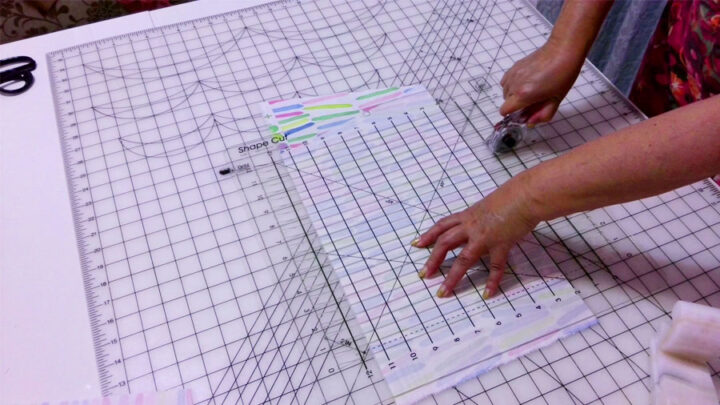
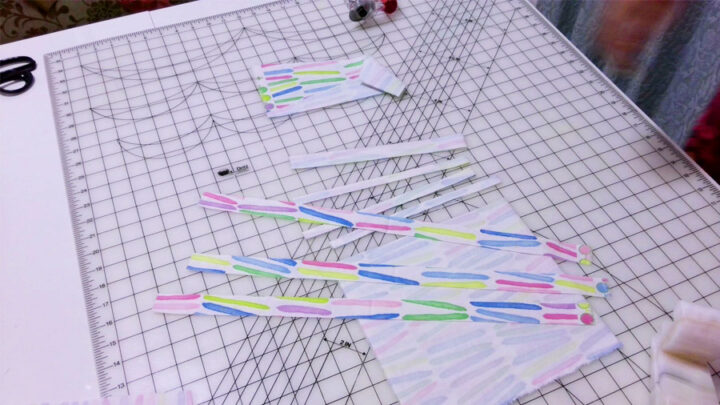
How To Cut Cloth Straight For Curtains
If you're cutting fabric for curtains, the process is not much different from cut fabric for whatsoever other sewing project. Curtains are usually made from woven fabric, and then the all-time mode to cut it straight is past pulling a thread. Only you can besides employ direct bending rulers, or cutting it using fabric prints/designs like stripes or geometric patterns that are often used for this kind of fabric.
The merely existent deviation when information technology comes to cutting fabric for curtains is that the pieces are ordinarily very big, then you may not take enough space on your table. In that case, just lay the textile out on the flooring and cut away.
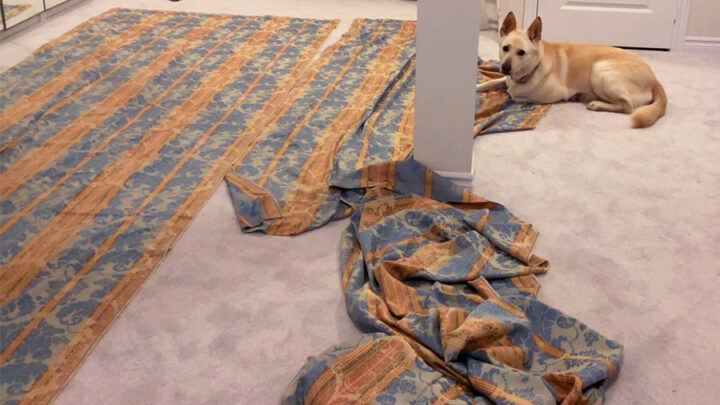
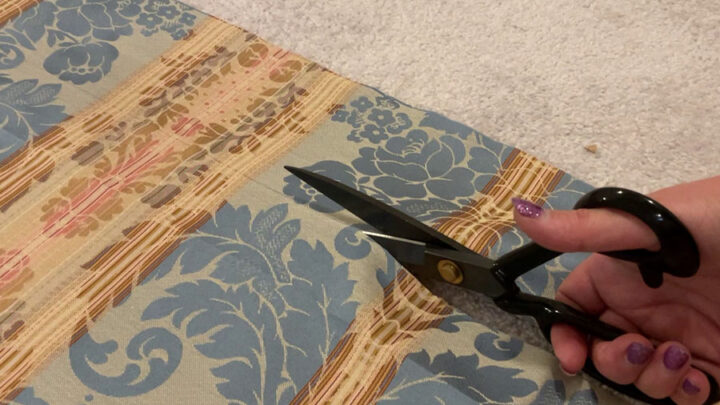
Easiest Fashion To Cut Cloth
Finding the easiest method for cut your cloth actually depends on what yous're doing. Sometimes scissors will be the all-time tool to use, while other times, a rotary cutter will be more efficient. I do recommend having both of these cutting tools at your disposal – you may not know which i is the best fit until y'all start your project.
How To Fold Fabric For Cutting
Information technology'south recommended to fold cloth selvage to selvage lengthwise and afterwards that cutting pattern pieces. The fabric fold should always be parallel to selvages and information technology means that the grainline of the fabric should be parallel to the fold – merely in this case your cuts will be right. Simply it's not ever piece of cake to practise. Sometimes you fold the fabric matching selvages and the fold has lots of bubbles as you come across in the paradigm beneath.
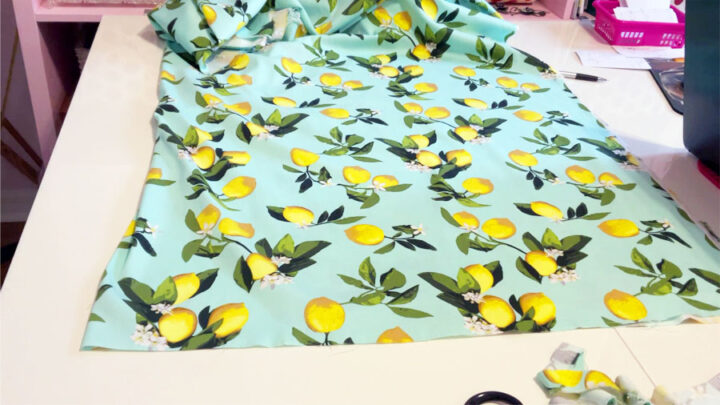
And then, what to do in this case? Move the selvages a trivial to the left or to the right to go the fold shine. Don't match the cut edges of the piece of fabric, they may not be cut directly.
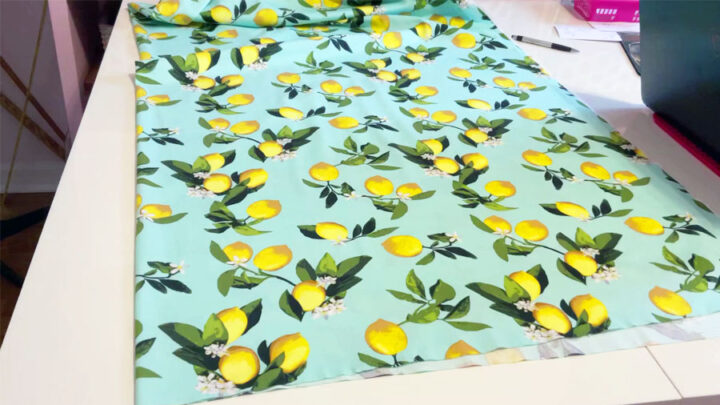
Cut Cloth Straight FAQs
Hither are some questions readers frequently ask nigh.
How To Cut Silk Fabric Straight
Silk and slippery fabrics are tricky to cut directly because they shift and slide as y'all cutting. Some people will spray them with starch to temporarily make them a niggling "sticky" so they stay in identify. I commonly use painter's tape to agree the fabric in place. The tape will non leave any marks on the fabric later you take information technology out and the fabric will non shift while you are marking the pattern edges. Information technology is better to embrace all sides of the fabric piece with the painter's tape if your table is big plenty.
You can read all about it in my tutorial How to cut chiffon without problems.
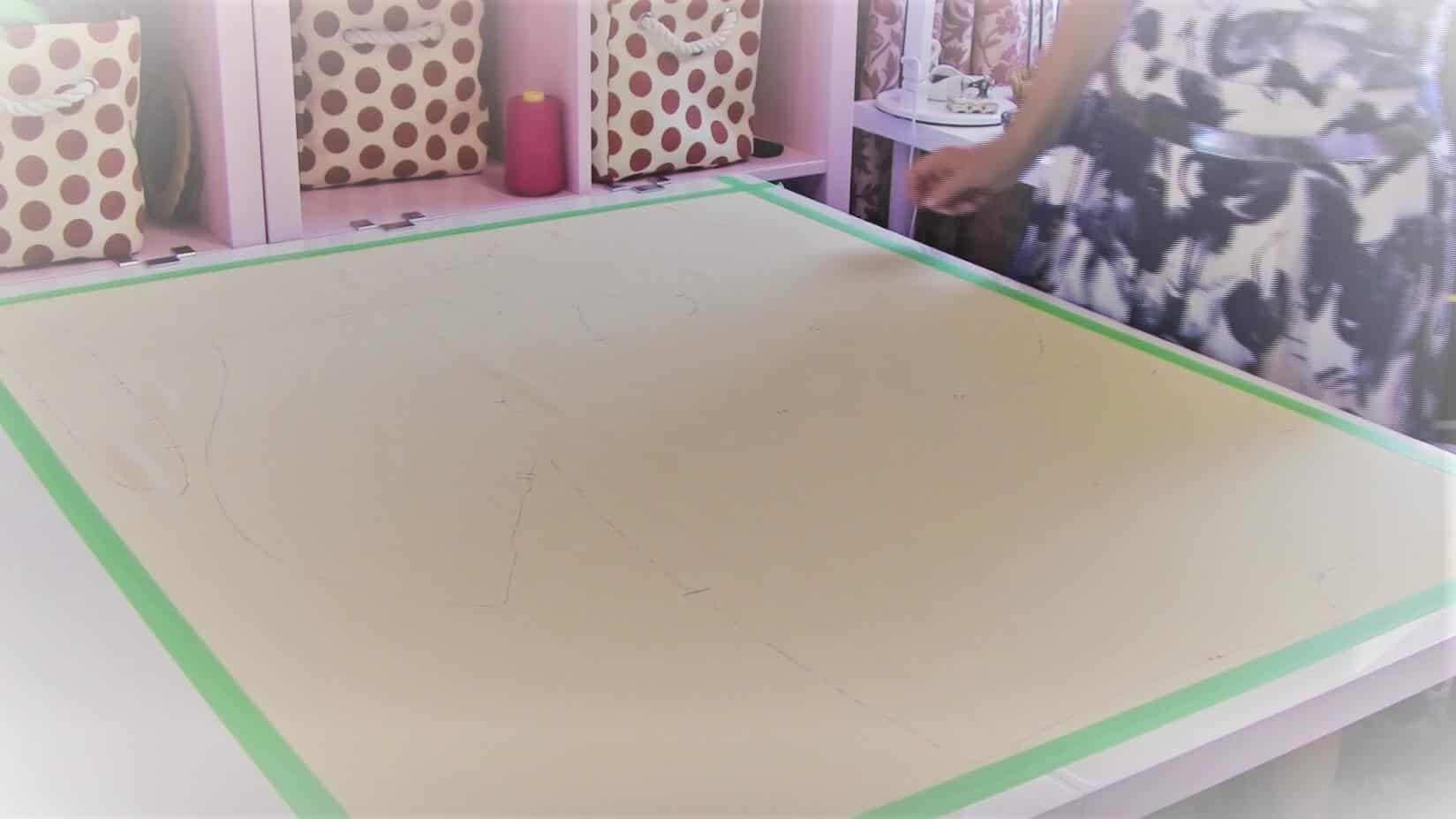
How To Cut Fleece Fabric Straight
Fleece is a heavy, thick knit textile, so if you lot cut it with scissors make sure they are very abrupt and able to cut thicker fabric. But it's better to cut fleece straight with a rotary cutter rather than pair of scissors. Use a 90-caste ruler that will requite you a perfectly straight line to follow for cutting. Identify the piece of fleece material on the cutting mat and and then line upward the ruler along the selvage edge of the fabric.
How To Cut Large Pieces Of Fabric Straight
If you need to cutting a piece of fabric that's larger than your cutting tabular array, you'll want to make sure y'all squared upward the fabric then that you can fold your textile and cut it straight that mode. Brand sure you accept a flat, hard work area that's big enough to work every bit you exercise this, so if your tabular array is not big plenty even for folded fabric use the floor. Cutting big pieces of textile tin can be catchy, merely squaring up the fabric beforehand will aid ensure that your cuts are straight.
Is the selvage border e'er straight?
Yes, nearly of time you can count on the selvage border being straight in textile (that has not even so been washed). Dissimilar cut edges, selvages are created by the manufacturer, which makes them helpful for determining whether your cut edges are straight or not. But in that location are manufacturer's defects sometimes and I had a few pieces of fabric with selvages that were non straight.
As well, after a textile is prewashed, the selvage edge tin curve as y'all tin can see in the paradigm below.
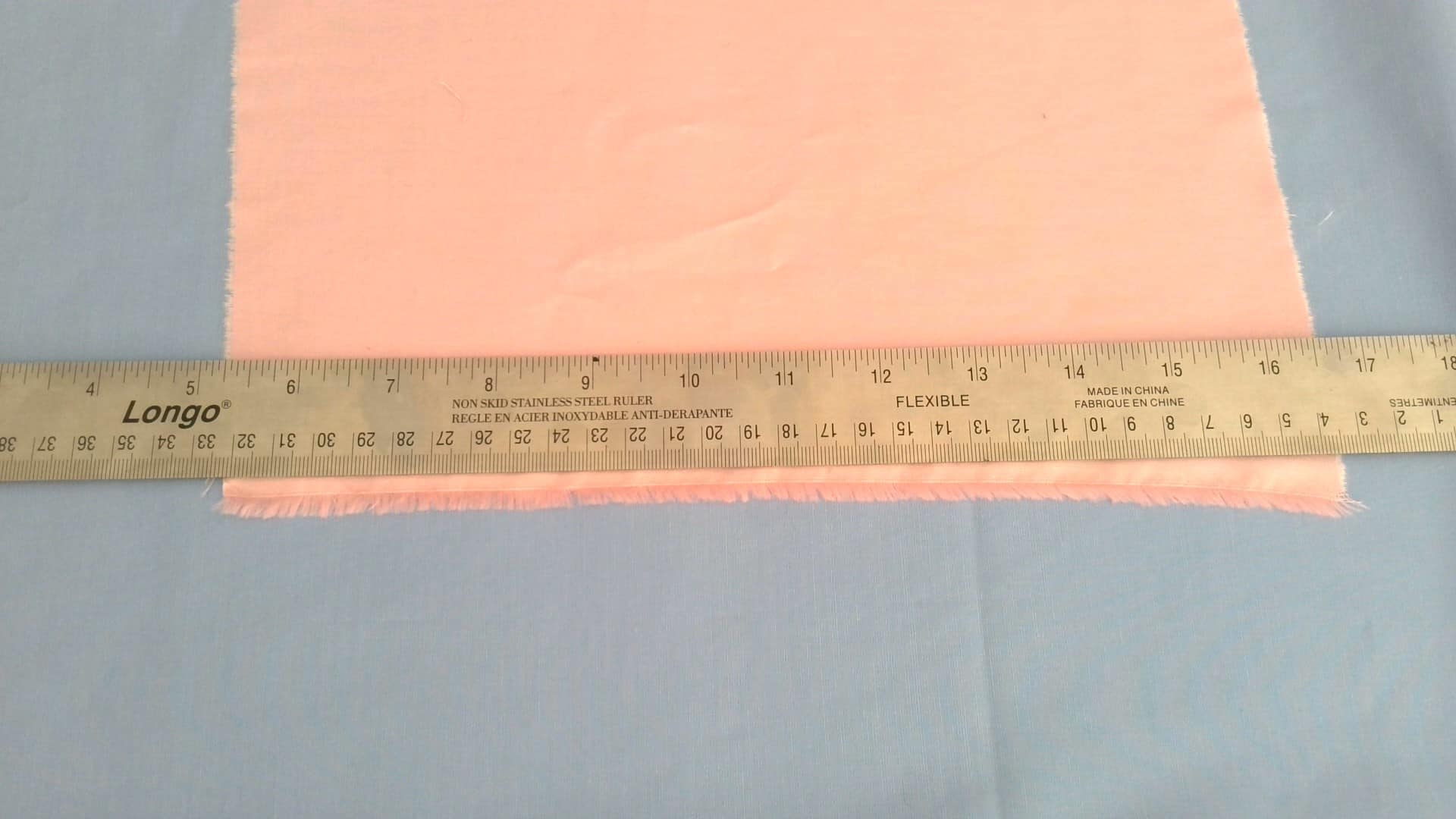
If you lot want actual examples of projects where I used some of the methods in a higher place, please expect at
Maxi dress DIY or How to make a robe without a pattern from pure silk fabric
I utilize these methods to cutting fabric perfectly straight and have definitely learned these tips and tricks through the school of experience. I hope this guide for cut cloth straight was helpful for you!
Once yous take your fabric cutting out straight, it's time to start sewing! Sewing straight is essential for whatever project, and so be sure to cheque out my tutorial on how to sew directly before y'all become started.
Desire to improve your sewing skills?
Get my detailed guide on SEWING MACHINE TENSION ADJUSTMENTS free!
Subscribe to my weekly newsletter with sewing tips and tutorials, free sewing patterns, printable PDFs, and other useful content and you lot'll find the eBook in your inbox.
Subscriber exclusive offering.
Don't miss the free HELPFUL eBook!
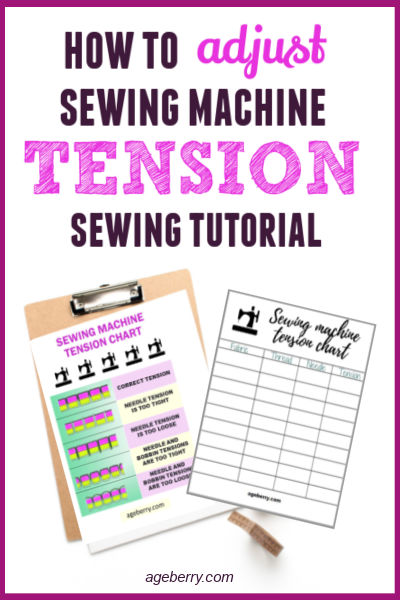
Exercise you have any questions? Exercise y'all know other methods to cut fabric straight? If you do, or accept any other suggestions, please utilize the section at the end of the folio to leave a annotate.
Did you like this tutorial? If you desire to save it for future reference and to utilize it subsequently when you are fix to cutting fabric, pin this paradigm to your sewing board on Pinterest and follow me on Pinterest for more tips, tutorials and inspiration.
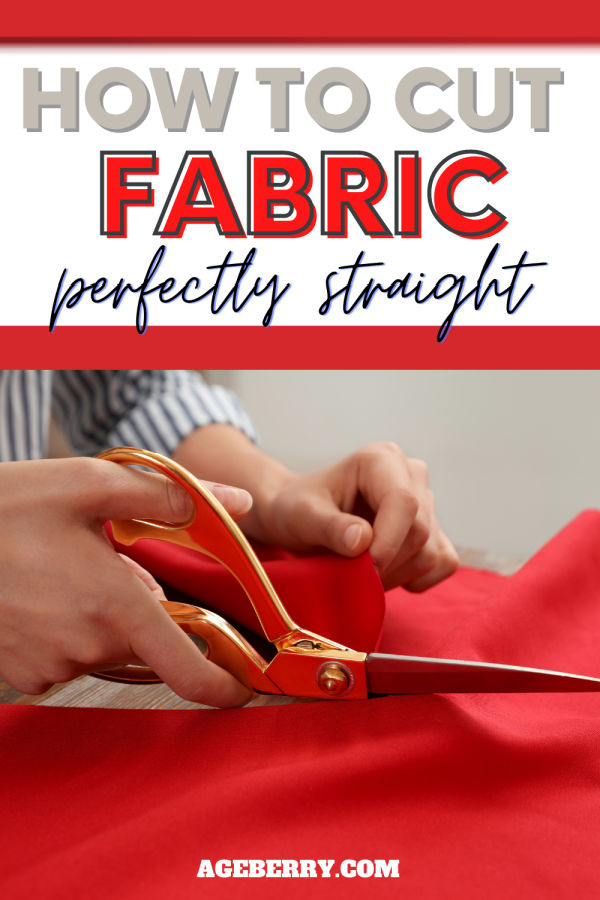
Fix to have the next pace in your sewing journey?
Cheque out more stride-by-stride tutorials from my site
Source: https://www.ageberry.com/how-to-cut-fabric-perfectly-straight/

0 Response to "How To Cut A Straight Line With Scissors"
Post a Comment